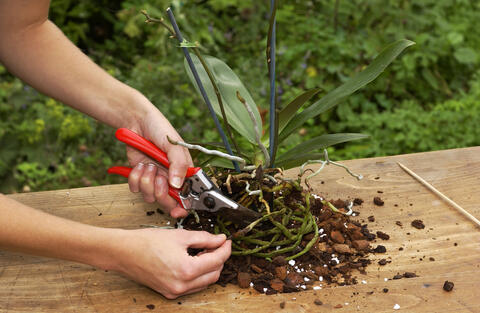The 5 Golden Rules of Orchid Care
There is hardly any other houseplant as popular as the Orchid. Since the exotic beauty asks a lot of its owners, we have compiled the five most important rules of Orchid care.

Flowers of a Moth Orchid (Phalaenopsis hybrid)
It is no surprise that caring for an Orchid is a little more challenging than looking after other houseplants. Most Orchid varieties, including Phalaenopsis, which are arguably the most popular Orchid of them all, grow as epiphytes on trees in the tropical forests of South America. Certain conditions need to be in place and some rules should be followed for Orchids to thrive indoors. We provide an overview of the most important ones.
When planting and repotting, never use normal potting soil. You should only use a special Orchid soil mix. It is particularly coarse and airy so to prevent waterlogging. The best time for repotting is after the plant has flowered in spring. Make sure to shake off all of the old soil from the root ball before putting the plant in the new pot. It should only be slightly larger than the previous pot, if at all. Check the roots for any rotten or dead areas and remove them using a sharp knife.

It’s important to choose the right planter so that your Orchid thrives. We recommend purchasing special Orchid pots. Thanks to their porous surface, clay pots can help sensitive plants to regulate the water supply. However, plastic pots made from transparent material are very common. These allow you to constantly monitor the roots of the plant. The roots of some orchids, for example the genus Cattleya, will not tolerate any wetness and need to be put in plastic baskets (we recommend those available for pond plants to provide better ventilation. Orchids that grow downwards (Stanhopea, Coryanthes and many others) are best off in hanging baskets or wood slat baskets. Classic orchid pots are made of ceramic and are remarkably tall. They have an integrated level so that the plant pot isn’t standing in water.
Note: Not all Orchid species are to be watered as usual after planting or repotting! Phalaenopsis, in particular, cannot tolerate this at all. You should instead mist the substrate with water each day to keep it moist. After two to three weeks, you can water or immerse the Orchid as normal.
Stagnant moisture leads to root rot for almost all Orchids and the plant dies soon after. Make sure that absolutely no water builds up in the plant pot or planter. When watering your Orchids with a spray bottle, never spray the plant directly. Always spray towards the substrate or roots. Water can collect in the leaf axils or buds and can cause them to rot.

Orchids prefer to be watered in the morning. Only use room temperature water with a very low lime content. Take the time to decalcify your water if necessary – you will be rewarded with beautiful flowers. You can also use rainwater in summer.
Both watering from above and immersing the pot in water have proven particularly successful. But you can also use a spray bottle or a plastic jug with a narrow neck. As already mentioned, you should only water the root ball and substrate; not the above ground parts of the plant. The watering method you choose depends on how much time you can spend caring for your Orchids. The only important thing is that you water Orchids differently to other houseplants and allow the plant to drain well before you put it back.
Fertilization is an essential part of good Orchid care. We recommend using special fertilizers for Orchids, which are available in stores. Wild Orchids do not need many nutrients, and the same is true of indoor Orchids. Fertilizers with a high salt concentration accumulate in the substrate and cause the plant to die. Orchid fertilizer is generally applied in low doses, but you can reduce the dosage even further to be on the safe side.

It is also very important to regularly remove withered Orchid stems. However, make sure to leave them on the plant until they have completely dried out. Only then cut them all the way back to the green part. Leave the base of the stem with at least two new buds.
- Only use special soil mixes and pots for Orchids
- Only spray the substrate or roots
- Water in the mornings using room temperature water with a low lime content
- Only use modest amounts of Orchid fertilizer
- Regularly remove withered and dried out stems



